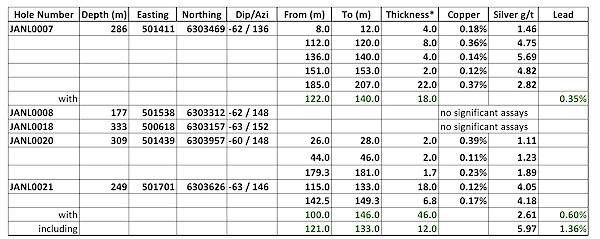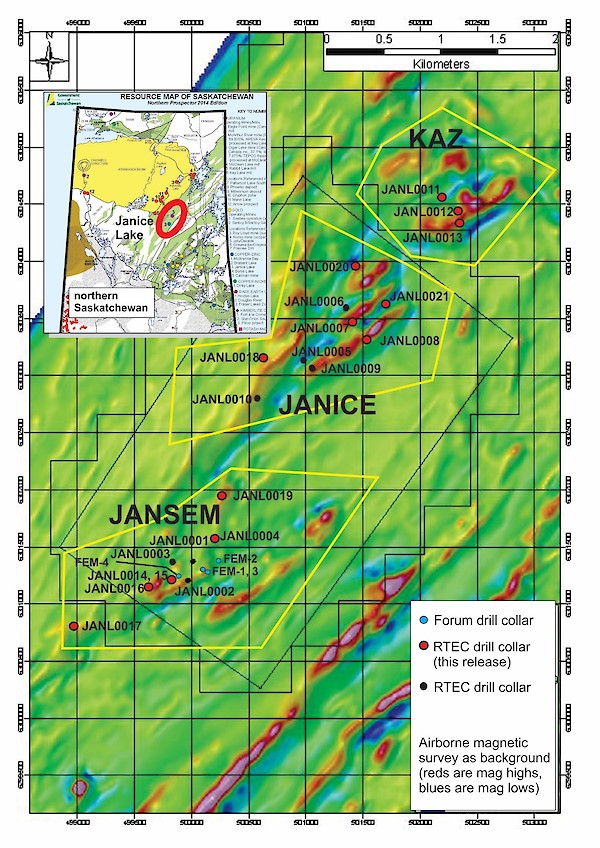Related Document
Vancouver, B.C., December 3, 2019 - Forum Energy Metals Corp. (TSX.V: FMC) (“Forum”) is pleased to announce that it has received final assay results from the remaining 12 drill holes completed at the Jansem, Janice, and Kaz targets within the Company’s Janice Lake sedimentary copper project (Figure 1). Multiple, thick, flat lying chalcocite mineralized horizons from surface have been intersected on the property.
Highlights
- Jansem - JANL0016 intersected 51.8m grading 0.57% Cu and 1.50 g/t Ag (116.2m to 168m), including 9.1m of 1.09% Cu and 1.39 g/t Ag (118.9m to 128m) and 5.0m grading 1.32% Cu and 3.42 g/t Ag (139.0m to 144.0m).
- Nine holes have delineated copper mineralization for 650 metres long by 200 metres wide by thicknesses up to 66 metres. The Jansem Target remains open to the southwest and northeast, and at depth.
- Janice – JANL0007 intersected 22m grading 0.37% Cu and 2.82 g/t Ag (185.0m to 207.0m).
- Nine holes have delineated copper mineralization for 1.2 kilometres long by 400 metres wide by thicknesses up to 57 metres. The Janice Target remains open to the southwest and northeast, and at depth.
This first phase of drilling completed by Rio Tinto Exploration Canada (RTEC) has successfully confirmed and extended copper mineralization at the Jansem and Janice targets. Forum and RTEC’s technical teams are reviewing the drill data and a more thorough analysis and interpretation of results are forthcoming.
Rick Mazur, President & CEO commented, “Drilling by Rio Tinto intersected thick zones of flat lying, stratabound chalcocite and native copper mineralization with good continuity and near-surface grades. Deeper drilling has demonstrated that multiple horizons of copper mineralization are present. We are gaining confidence that Janice Lake is a strongly mineralized system, as new data generated by this program helps us to understand the full potential of this 52km long sedimentary copper basin.”
Jansem Target Drillhole Summaries (Table 1)
Drilling intersected several layers of copper mineralization, starting from 11 metres to a maximum downhole depth of 220 metres. Estimated true thickness varies from several metres to more than 60m. Drill holes were orientated to crosscut the stratigraphy as close as possible at right angles, as the copper is interpreted to be mostly stratabound.
- Hole JANL0014 was drilled to a depth of 189 metres and intersected a 66 metre zone of copper mineralization starting at surface within psammitic to psammo-pelitic gneisses and conglomerates, and continuing down to 77 metres. This hole is part of a two-hole fence with JANL0015, which were designed to test the along-strike and down-dip extensions of copper mineralization intersected in JANL0002.
- Hole JANL0016 was drilled to a depth of 252 metres but was orientated to the NW instead of the SE like all the other holes in this program. Strong and continuous copper mineralization was intersected from 116m to 168m.This hole intersected the upper section of the Rafuse Fm and encountered calc-silicates in the upper part of the hole, then psammo-pelitic gneisses.
- Hole JANL0017 was collared approximately 600m to the southwest of JANL0016, drilled to a depth of 287.5 metres and is the south-westernmost hole of the season. The presence of calc-silicates throughout the hole suggests that it is located in the upper Rafuse Fm. No mineralization was noted.
- Hole JANL0019 was drilled to a depth of 186 metres and is the northernmost hole on the Jansem target, aiming at a small magnetic high that is not connected with the main Jansem zone. The hole intersected mainly barren meta-conglomerates.
Table 1: Jansem Target Assay Results

*Drill holes were oriented to crosscut the stratigraphy, however, true widths of the reported mineralized intervals have not yet been determined,
Janice Target Drillhole Summaries (Table 2)
Drilling intersected several layers of Cu mineralization, starting from 8 metres to a maximum downhole depth of 358 metres. Estimated true thickness varies from several metres to more than 50m. Drill holes were orientated to crosscut the stratigraphy as close as possible at right angles, as the copper is interpreted to be mostly stratabound.
- Hole JANL0007 was drilled to a depth of 286 metres and was the middle hole of a three-hole fence including holes JANL0006 and JANL0008. This hole intersected five zones of copper mineralization starting immediately beneath the overburden, and continued to a depth of 207 metres within psammo-pelitic gneisses and meta-conglomerates. An eighteen-metre section of lead was also intersected between two zones of copper mineralization.
- Hole JANL0008 was drilled to a depth of 177 metres and was the southeastern-most hole in the three-hole fence. This hole was located too far to the southeast and was out of the mineralized zone.
- Hole JANL0018 was drilled to a depth of 333 metres and was located approximately 400m west of hole JANL0005, across an interpreted major structure to see if a semi-parallel magnetic high was also mineralized. This hole intersected mainly meta-conglomerates and a thick section of meta-pelitic gneisses that showed increasing structural deformation with depth – probably related to the major structure noted in the airborne magnetic survey.
- Hole JANL0020 was drilled to a depth of 309 metres and was the northern-most hole on the Janice Target, collared approximately 400m north of hole JANL0006. This hole intersected mainly psammo-pelitic gneisses and minor meta-conglomerates, with sections of weak, finely disseminated chalcocite mineralization.
- Hole JANL0021 was drilled to a depth of 249 metres and targeted the north-eastern end of the magnetic high. This hole intersected mostly psammo-pelitic gneisses, with a weak zone of copper mineralization from 115 to 149m, and a moderate zone of lead mineralization from 100 to 146m, which may represent part of the chemical zoning of the system.
Table 2: Janice Target Assay Results

* Drill holes were oriented to crosscut the stratigraphy, however, true widths of the reported mineralized intervals have not yet been determined.
Kaz Target Drillhole Summaries (Table 3)
- Hole JANL0011 was drilled to a depth of 274 metres and was the northernmost hole of a three hole fence that investigated the western end of the Kaz area. This hole intersected mostly psammo-pelitic to pelitic gneisses and meta-conglomerates that contained minor remobilized native copper and rare chalcocite. A major fault was noted at 188m and the remainder of the hole was in the lower Janice Lake Fm. meta-conglomerates.
- Hole JANL0012 was drilled to a depth of 216 metres and was the center of the fence. This intersected a thick sequence of psammo-pelitic to pelitic gneisses with weak copper mineralization from 105 to 110 metres. This hole also intersected a major structure that marked the border with the lower Janice Lake Fm.
- Hole JANL0013 was drilled to a depth of 159 metres and was the south-east hole on the fence. It also intersected a mix of psammo-pelitic to pelitic gneisses with a weak zone of copper mineralization from 25 to 29 metres, possibly the same zone intersected in JANL0012.
Noranda discovered a series of copper-bearing boulders in the KAZ area and followed-up with drill hole PL93-5, which intersected 0.32% copper over 15 metres. The 2019 holes drilled by RTEC were located approximately 400 to 500m to the south of the original showing, and the lower mineralized unit is interpreted to have been faulted away along this section. Further drilling on this showing will have to be located closer to the original holes to understand its control and orientation.
Table 3: Kaz Target Assay Results

* Drill holes were oriented to crosscut the stratigraphy, however, true widths of the reported mineralized intervals have not yet been determined.
A complete set of drill results and a plan map have been posted to the Home Page of Forum’s website at https://forumenergymetals.com/ All drill core samples were sent to ALS Global in Vancouver, BC for assay. Ken Wheatley, P.Geo. and Forum’s VP, Exploration and Qualified Person under National Instrument 43-101, has reviewed and approved the contents of this news release.

Figure 1: Location of the Target Areas on the Janice Lake Project
Quality Control/ Quality Assurance
Core samples were sawed in half, keeping the half with the reference line for orientated core in the box. Samples averaged 2 metres in length through the mineralized zone, 4 metres in length in the unmineralized zone, however these lengths varied depending on stratigraphy, alteration or mineralization. Standards were introduced after every 20th sample, using a high grade, low grade or unmineralized, depending on the surrounding core. Duplicates were also introduced on every 20th sample, quartering the core. Blanks were used for the first sample of the hole and at the beginning and end of a mineralized interval, using certified rose quartz. The first two holes of this drill program had blank material inserted after every sample that had visual chalcocite and native copper to determine the potential smear effect. This would allow to modifications in the sample preparation for future holes in this program. A 4-acid digestion was used on the samples at ALS lab in Vancouver, followed by analysis by ICP-MS (the ME-MS61L package). Higher grade samples will be run again through copper screen using the coarse reject material.
Janice Lake Summer Exploration Program Summary
RTEC completed a 4,318 line kilometre high resolution airborne magnetic survey over the entire 52 km length of the property and drilled 21 holes totalling 5,209 metres this summer under an Option Agreement to earn an 80% interest in the Janice Lake project by spending $30 million in exploration. Nine holes have been completed on the Jansem target, nine on the Janice target and three on the Kaz target.
About Forum Energy Metals
Forum Energy Metals Corp (TSX.V: FMC) explores for energy metals, including copper, nickel, platinum, palladium and uranium in Saskatchewan, Canada’s Number One mining province. In addition, Forum has also established a strategic land position in the Idaho Cobalt Belt. For further information: www.forumenergymetals.com
ON BEHALF OF THE BOARD OF DIRECTORS
Richard J. Mazur, P.Geo.
President & CEO
Neither the TSX Venture Exchange nor its Regulation Services Provider (as that term is defined in the policies of the TSX Venture Exchange) accepts responsibility for the adequacy or accuracy of this release.
For further information contact:
| NORTH AMERICA Rick Mazur, P.Geo., President & CEO mazur@forumenergymetals.com Tel: 778-772-3100 Craig Christy, VP Corporate Development cchristy@forumenergymetals.com Tel: 250-863-0561 |
UNITED KINGDOM Burns Singh Tennent-Bhohi, Director burnsstb@forumenergymetals.com Tel: 074-0316-3185 |

